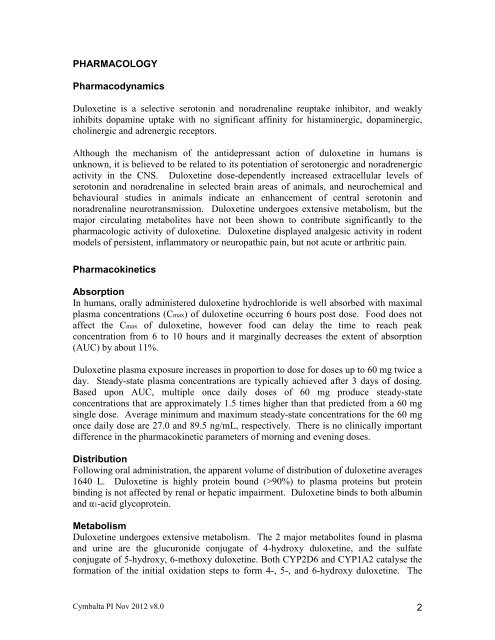cymbalta - Drivetime Radio
cymbalta - Drivetime Radio cymbalta - Drivetime Radio
PHARMACOLOGYPharmacodynamicsDuloxetine is a selective serotonin and noradrenaline reuptake inhibitor, and weaklyinhibits dopamine uptake with no significant affinity for histaminergic, dopaminergic,cholinergic and adrenergic receptors.Although the mechanism of the antidepressant action of duloxetine in humans isunknown, it is believed to be related to its potentiation of serotonergic and noradrenergicactivity in the CNS. Duloxetine dose-dependently increased extracellular levels ofserotonin and noradrenaline in selected brain areas of animals, and neurochemical andbehavioural studies in animals indicate an enhancement of central serotonin andnoradrenaline neurotransmission. Duloxetine undergoes extensive metabolism, but themajor circulating metabolites have not been shown to contribute significantly to thepharmacologic activity of duloxetine. Duloxetine displayed analgesic activity in rodentmodels of persistent, inflammatory or neuropathic pain, but not acute or arthritic pain.PharmacokineticsAbsorptionIn humans, orally administered duloxetine hydrochloride is well absorbed with maximalplasma concentrations (Cmax) of duloxetine occurring 6 hours post dose. Food does notaffect the Cmax of duloxetine, however food can delay the time to reach peakconcentration from 6 to 10 hours and it marginally decreases the extent of absorption(AUC) by about 11%.Duloxetine plasma exposure increases in proportion to dose for doses up to 60 mg twice aday. Steady-state plasma concentrations are typically achieved after 3 days of dosing.Based upon AUC, multiple once daily doses of 60 mg produce steady-stateconcentrations that are approximately 1.5 times higher than that predicted from a 60 mgsingle dose. Average minimum and maximum steady-state concentrations for the 60 mgonce daily dose are 27.0 and 89.5 ng/mL, respectively. There is no clinically importantdifference in the pharmacokinetic parameters of morning and evening doses.DistributionFollowing oral administration, the apparent volume of distribution of duloxetine averages1640 L. Duloxetine is highly protein bound (>90%) to plasma proteins but proteinbinding is not affected by renal or hepatic impairment. Duloxetine binds to both albuminand α1-acid glycoprotein.MetabolismDuloxetine undergoes extensive metabolism. The 2 major metabolites found in plasmaand urine are the glucuronide conjugate of 4-hydroxy duloxetine, and the sulfateconjugate of 5-hydroxy, 6-methoxy duloxetine. Both CYP2D6 and CYP1A2 catalyse theformation of the initial oxidation steps to form 4-, 5-, and 6-hydroxy duloxetine. TheCymbalta PI Nov 2012 v8.0 2
metabolites circulating in plasma are in the conjugated form and are notpharmacologically active.ExcretionThe half-life of duloxetine (unchanged drug) is 12.1 hours. Apparent plasma clearance ofduloxetine after an oral dose is 101 L/hr. The majority (70%) of the duloxetine dose isrecovered in the urine as conjugated metabolites of oxidative metabolites of duloxetine.Approximately 20% of the dose is recovered in the faeces as unchanged drug,unconjugated metabolites, or unidentified compounds. Only trace (
- Page 1: CYMBALTA ®(duloxetine hydrochlorid
- Page 5 and 6: evaluation of efficacy of duloxetin
- Page 7: diary, Brief Pain Inventory Severit
- Page 12 and 13: those receiving antidepressants. Th
- Page 14 and 15: Activation of ManiaIn placebo-contr
- Page 16 and 17: Orthostatic Hypotension and Syncope
- Page 18 and 19: maximum recommended dose. In rats r
- Page 20 and 21: famotidine had no significant effec
- Page 22 and 23: Table 5: Treatment-Emergent Adverse
- Page 24 and 25: System Organ Class /Adverse Reactio
- Page 26 and 27: Renal and Urinary DisordersCommon:
- Page 28 and 29: Adverse Events - causality not esta
- Page 30: PRESENTATIONCapsules containing 30
PHARMACOLOGYPharmacodynamicsDuloxetine is a selective serotonin and noradrenaline reuptake inhibitor, and weaklyinhibits dopamine uptake with no significant affinity for histaminergic, dopaminergic,cholinergic and adrenergic receptors.Although the mechanism of the antidepressant action of duloxetine in humans isunknown, it is believed to be related to its potentiation of serotonergic and noradrenergicactivity in the CNS. Duloxetine dose-dependently increased extracellular levels ofserotonin and noradrenaline in selected brain areas of animals, and neurochemical andbehavioural studies in animals indicate an enhancement of central serotonin andnoradrenaline neurotransmission. Duloxetine undergoes extensive metabolism, but themajor circulating metabolites have not been shown to contribute significantly to thepharmacologic activity of duloxetine. Duloxetine displayed analgesic activity in rodentmodels of persistent, inflammatory or neuropathic pain, but not acute or arthritic pain.PharmacokineticsAbsorptionIn humans, orally administered duloxetine hydrochloride is well absorbed with maximalplasma concentrations (Cmax) of duloxetine occurring 6 hours post dose. Food does notaffect the Cmax of duloxetine, however food can delay the time to reach peakconcentration from 6 to 10 hours and it marginally decreases the extent of absorption(AUC) by about 11%.Duloxetine plasma exposure increases in proportion to dose for doses up to 60 mg twice aday. Steady-state plasma concentrations are typically achieved after 3 days of dosing.Based upon AUC, multiple once daily doses of 60 mg produce steady-stateconcentrations that are approximately 1.5 times higher than that predicted from a 60 mgsingle dose. Average minimum and maximum steady-state concentrations for the 60 mgonce daily dose are 27.0 and 89.5 ng/mL, respectively. There is no clinically importantdifference in the pharmacokinetic parameters of morning and evening doses.DistributionFollowing oral administration, the apparent volume of distribution of duloxetine averages1640 L. Duloxetine is highly protein bound (>90%) to plasma proteins but proteinbinding is not affected by renal or hepatic impairment. Duloxetine binds to both albuminand α1-acid glycoprotein.MetabolismDuloxetine undergoes extensive metabolism. The 2 major metabolites found in plasmaand urine are the glucuronide conjugate of 4-hydroxy duloxetine, and the sulfateconjugate of 5-hydroxy, 6-methoxy duloxetine. Both CYP2D6 and CYP1A2 catalyse theformation of the initial oxidation steps to form 4-, 5-, and 6-hydroxy duloxetine. TheCymbalta PI Nov 2012 v8.0 2



